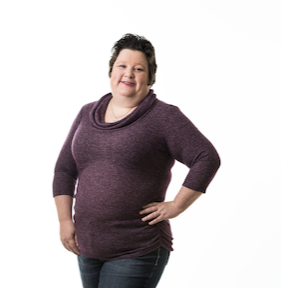
My New Normal
By Missouri Cancer Associates
Winter months are notorious for cold and flu season, and in February 2016, Emily Hawkins was sick. Without a primary doctor, she went to an urgent care center. Within nine days, she returned to the clinic five times, walking away with diagnoses of strep throat and thrush – but finding no relief for her malaise or the headaches and fatigue she felt. Emily went to Boone Hospital Center to have some tests done.
On February 18, Emily was told she had acute myeloid leukemia. She remembers feeling lonely while her parents were still driving from their home in Iowa to Columbia, knowing their daughter was sick, but not knowing how sick.
“That day I heard three words that would change me forever,” Emily says. “‘You have leukemia.’”
Battling for her life, suffering from a greatly compromised immune system, she didn’t leave the hospital for the next 25 days.
“I wanted to know why,” Emily says. “I wanted to know what had happened to cause this.”
The answer was that they don’t know what causes leukemia. She hadn’t done anything that caused her to develop the disease. In fact, AML in someone Emily’s age is a rarity – the disease most often afflicts young children or those older in age.
That day she met people who would soon become staunch allies in her fight against cancer, including Mark Tungsevik, MD from Missouri Cancer Associates (MCA) and Mung Chin, her nurse navigator (now a nurse at MCA), who would become one of her best friends through the course of her journey.
Dr. Tungsevik immediately ordered a bone marrow biopsy. Friends from her job as operations manager at Caledon Virtual came to the hospital to see her. She called her parents in the car and told them the news.
“It was shock and whirlwind,” Emily says.
Twenty-four hours later, the biopsy results confirmed the initial leukemia diagnosis and put chemotherapy treatment immediately into motion. Mung explained the side effects that seven straight days of chemo may have – hair loss, nausea and vomiting.
“The staff at MCA and Boone got me through everything,” Emily says, looking back over the past year. “I spent a total of more than 65 days at the hospital, developing relationships with the doctors, nurses and staff that truly did help save my life. The team knew me and my family so well and treated us with incredible care and love that we will never forget.”
The chemotherapy side effects turned out to be of less concern than how sick and fatigued she felt because of her compromised immune system. She spent more than two weeks being able to eat or drink very little and receiving so many blood and plasma transfusions that she lost count.
“When people think about cancer, they might think about chemo and radiation – going and getting treatment at a clinic,” she says. “That’s not what I went through. There were no decisions to be made, no time to set a plan or consider options. We just did it.”
Twenty-five days after being admitted to Boone, Emily was finally able to go home, but her treatment wasn’t over. She prepared herself for what she expected to be the next step, a bone marrow transplant, and arrived with her parents at Siteman Cancer Center in St. Louis for a meeting with Peter Westervelt, MD, PhD, a bone marrow transplant and leukemia specialist.
Emily was ready to stay in St. Louis for 30 days, which the transplant would require, but at Siteman, she received a lesson in relinquishing control.
“I went there with one idea – bone marrow transplant,” Emily says.
A planner by nature, she was upset at first to learn that the bone marrow transplant she expected wasn’t the recommended course of action. Instead, she began a four-month journey on consolidated chemo, with the knowledge the treatment held a 35-to-40 percent chance of success.
The next four months unfolded into regular cycles of consolidated chemo rounds, returning home, getting sick and heading back to the hospital.
“My body was amazing, like clockwork,” Emily says.
On July 19, 2016, she finished her last round of chemo. She was an emotional mess.
“When it was over, I was not okay,” she says. “I was trying to figure out what to do next.”
By mid-August, she was back at work. The 35-to-40 percent success rate for the consolidated chemo hung over her head. She waited for the cancer to come back.
A month later, she said something “finally clicked.”
Today, a year later, Emily has come through to the other side of cancer treatment: remission. Grateful for those who helped her along the way, she says she’s learned to trust life again – through a journey that started with a whirlwind and taught her lessons in acceptance and taking things as they come.
She’s now back to work full time at Caledon Virtual, in a new relationship, and enjoying life. She gives thanks to her parents, Norm and Shelley Hawkins, for their support through her journey.
“They put their lives on hold to help save mine,” she says. She also expresses gratitude for the staff at MCA and Boone Hospital.